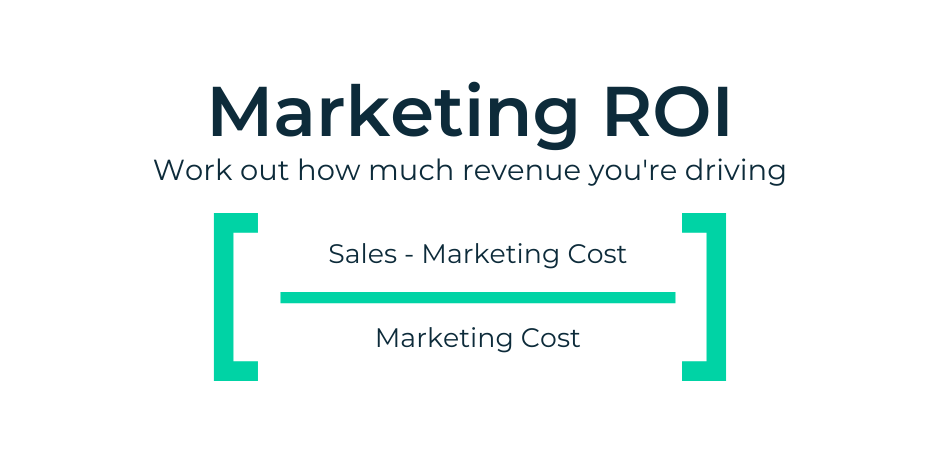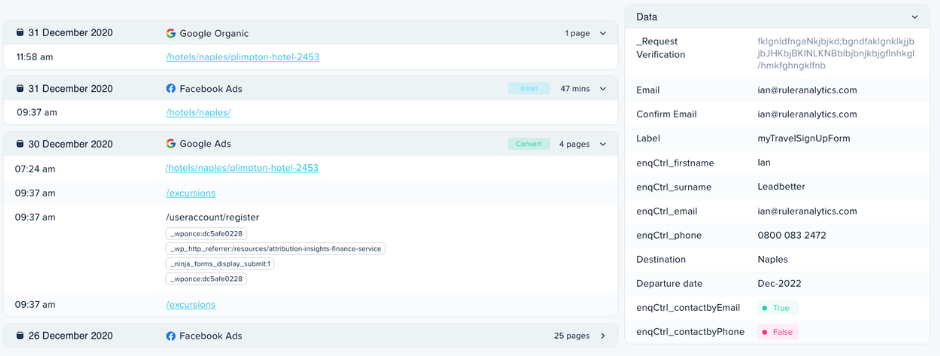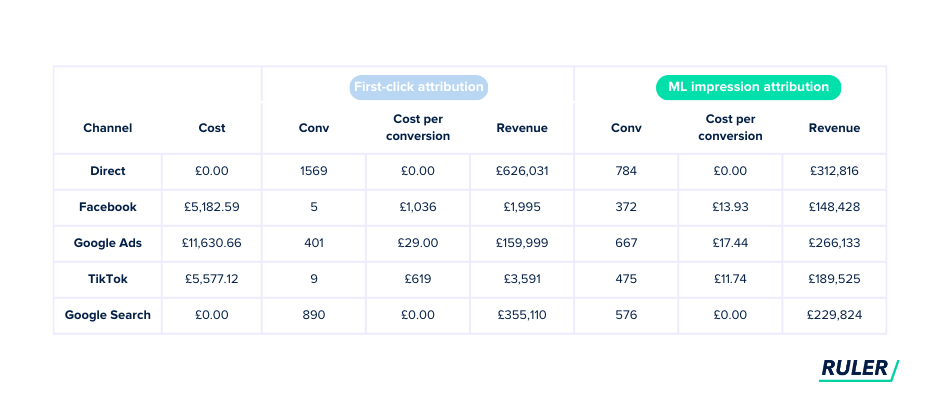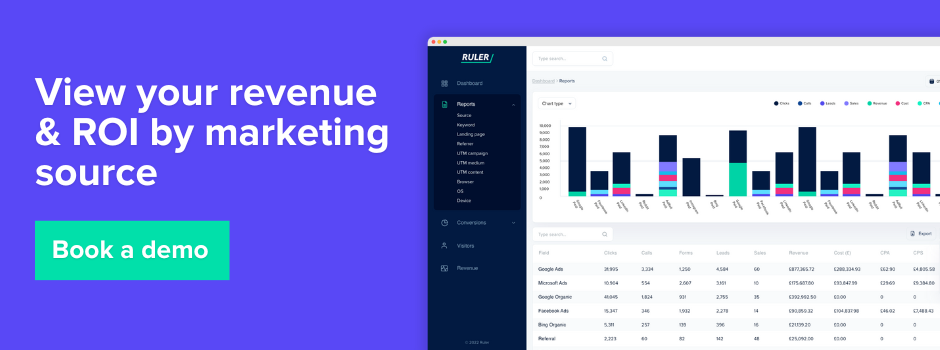We explore what marketing ROI is and how you can track and calculate it.
Marketers know that to improve and grow, you need to have a good understanding of what’s working and what isn’t. Marketing return on investment is a key metric when it comes to determining your success.
We found that 60% of marketers are confident they prove marketing ROI, but just 23% of marketers are confident that they’re tracking the right KPIs.
What are the stumbling blocks in the way of marketers calculating their ROI? Keep reading to learn:
💡 Pro Tip
Ruler tracks marketing ROI by mapping the entire user journey, starting from the first interaction and following it through to conversion. It uses click path data to analyse how different touchpoints contribute to lead generation and revenue. In cases where unique identifiers are not available, Ruler employs machine learning models to estimate impressions and link them to revenue, allowing for reattribution and a comprehensive assessment of the impact of top-of-funnel activities on overall marketing performance.
Book a demo to see how Ruler tracks ROI
Marketing ROI, or marketing return on investment, is a key metric to determine how much return you get from marketing investments you make.
For example, you set a PPC campaign live and it costs £500. You want to know how many sales you created on the back of this £500 investment.
The more sales you make, the more successful the campaign is. Marketing ROI helps you understand just how many sales and how much revenue you’re driving through marketing.
Calculating return on investment is easy. All you need to do is subtract your marketing cost from your sales. You then divide that figure by your marketing cost.
Related: 5 Marketing ROI tools you need to measure success
(Sales Growth – Marketing Cost) / Marketing Cost = ROI

This calculation can be applied to all of your marketing, or you can break it down by channel or even campaign to understand your ROI on a holistic or individual basis.
There are a few key factors why marketing ROI is so difficult to track. We’ve broken it down to three main reasons.
Your lead and marketing data is out there, but it’s often disconnected at every stage of the journey.
Let’s break it down.
A user visits your website multiple times before they finally convert by filling out a form.
Sure, you might be tracking that form fill, but how are you connecting that conversion to their entire customer journey?
And when that lead turns into a sale, how do you link that revenue back to everything they did before buying?
The missing step here is marketing attribution.
It helps you track every lead and touchpoint, giving you full visibility into how your audience interacts with your brand.
Take Ruler, for example.
It tracks anonymous visitors to your site across multiple sessions, sources, and keywords.

Once someone converts—whether it’s via phone call, form, or live chat—Ruler integrates with your CRM (or wherever you store lead data) and sends the important info over.
Then, when a sale is closed, Ruler pulls the revenue data back into its dashboard and your marketing analytics tools like Google Analytics and ad platforms.
This way, you can track real sales and revenue and get a much clearer picture of your ROI.
💡 Pro Tip
Ruler gives you a clear, unbiased view of how all your marketing channels are performing so you can optimise and scale with confidence. Plus, it makes it easier to show leadership the real impact of your efforts.
Book a demo to see how it tracks ROI
One of the biggest hurdles is the growing number of privacy restrictions and limited tracking capabilities.
For example, Apple has taken major steps to protect user privacy with features like App Tracking Transparency (ATT) and Intelligent Tracking Prevention (ITP).
ATT gives users the power to opt out of being tracked by apps, which seriously limits the amount of data platforms like Meta can collect.
Then there’s ITP, which reduces the lifespan of first-party cookies in Safari to just 1–7 days, depending on your settings.
This might not sound like much, but it’s a huge deal for marketers because it makes it tough for analytics tools to follow users across their entire journey.
And it’s not just Apple. People are actively blocking trackers on their own too. They’re using ad blockers to, not only stop ads, but also block companies from gathering user data.
With all of these factors combined, marketers are left with less data to analyse, making it a lot harder to track ROI and measure how successful their campaigns actually are.
Most marketers lean on GA4 to measure how well their campaigns are performing, despite its lack of ability to like traffic and conversions to actual pipeline—but that’s a whole different in itself.
Related: 6 limitations of Google Analytics 4 and how to overcome them
A lot of the time, people might see an ad or engage with a brand offline over a period of time.
But when they’re ready to take the next step, they’ll often search for the brand directly or through organic search.
The problem here is that Google Analytics doesn’t track impressions – it only sees the clicks.
So, all the credit gets dumped onto organic or direct, even though other channels may have done the heavy lifting in nudging the person toward conversion.
This makes upper funnel channels like Meta, TikTok, YouTube, look less effective, resulting in lower ROI and higher cost per acquisition costs.
To tackle this, we’ve introduced something called impression modelling alongside our traditional click-based tracking.
Related: Future of measurement: The role of impression attribution
Using Bayesian statistics, we’ve created algorithms that link ad impressions to conversions, even when there’s no direct click involved.
Once those impressions are connected, we apply Shapley Regression to make sure every touchpoint gets its fair share of credit – not just the final click.

This process helps us redistribute credit away from organic and direct traffic to the channels that truly deserve it, helping us uncover the real ROI from campaigns that don’t always end with a click but play a crucial role in conversions and revenue.
Understanding why tracking ROI is so challenging and knowing the formula behind it sets you on the right path to effectively measure what’s working and what isn’t.
With a tool like Ruler, you can map out click-path journeys, track leads, and capture all the touchpoints along the way.
Plus, with impression modelling, you’ll finally gain visibility into the ROI of those upper-funnel campaigns that used to be nearly impossible to track.
Find out more about Ruler and book a demo with the team. We’ll show you how to prove your return on investment right in our dashboard.
